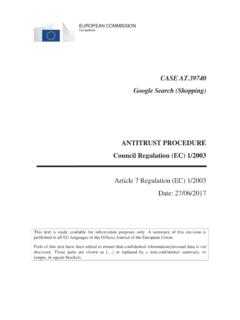Transcription of Video Games an d Aggressive Thoughts, Feelings and …
1 Journal of Personality and Social Psychology2000, Vol. 78, No. 4, 772-790 Copyright 2000 by the American Psychological Association, $ DOI: Games and Aggressive Thoughts, Feelings , and Behavior inthe Laboratory and in LifeCraig A. AndersonUniversity of Missouri ColumbiaKaren E. DillLenoir-Rhyne CollegeTwo studies examined violent Video game effects on aggression-related variables. Study 1 found that real-lifeviolent Video game play was positively related to Aggressive behavior and delinquency. The relation wasstronger for individuals who are characteristically Aggressive and for men. Academic achievement wasnegatively related to overall amount of time spent playing Video Games . In Study 2, laboratory exposure to agraphically violent Video game increased Aggressive thoughts and behavior. In both studies, men had a morehostile view of the world than did women.
2 The results from both studies are consistent with the GeneralAffective Aggression Model, which predicts that exposure to violent Video Games will increase aggressivebehavior in both the short term ( , laboratory aggression) and the long term ( , delinquency).On April 20, 1999, Eric Harris and Dylan Klebold launched anassault on Columbine High School in Littleton, Colorado, murder-ing 13 and wounding 23 before turning the guns on it is impossible to know exactly what caused these teensto attack their own classmates and teachers, a number of factorsprobably were involved. One possible contributing factor is violentvideo Games . Harris and Klebold enjoyed playing the bloody,shoot-'em-up Video game Doom, a game licensed by the to train soldiers to effectively kill. The Simon WiesenthalCenter, which tracks internet hate groups, found in its archives acopy of Harris' web site with a version of Doom that he hadcustomized.
3 In his version there are two shooters, each with extraweapons and unlimited ammunition, and the other people in thegame can't fight back. For a class project, Harris and Kleboldmade a videotape that was similar to their customized version ofDoom. In the Video , Harris and Klebold dress in trench coats, carryguns, and kill school athletes. They acted out their videotapedperformance in real life less than a year later. An investigatorassociated with the Wiesenthal Center said Harris and Kleboldwere "playing out their game in God mode" (Pooley, 1999, p. 32).Entertainment media affects our lives. What behaviors childrenand adults consider appropriate comes, in part, from the lessons welearn from television and the movies ( , Huesmann & Miller,Craig A. Anderson, Department of Psychology, University of Mis-souri Columbia; Karen E.)
4 Dill, Department of Psychology, research was supported by the Psychology Department at the Univer-sity of Missouri Columbia. We thank Julie Tuggle, Luisa Stone, Kathy Neal,Shelby Stone, and Lynn McKinnon for dieir assistance in collecting data. Wealso thank William Benoit, Brad Bushman, Russell Geen, Mary Heppner, andMichael Stadler for comments on drafts of this concerning this article should be addressed to Craig , who is now at the Department of Psychology, W112 Lagomar-cino Hall, Iowa State University, Ames, Iowa 50014, or to Karen E. Dill,Department of Psychology, Lenoir-Rhyne College, Box 7335, Hick-ory, North Carolina 28603. Electronic mail may be sent to Craig at or to Karen E. Dill at There are good theoretical reasons to expect that violentvideo Games will have similar, and possibly larger, effects onaggression. The empirical literature on the effects of exposure tovideo game violence is sparse, however, in part because of itsrelatively recent emergence in modern society.
5 About 25years ago, when Video Games first appeared, popular Games weresimple and apparently harmless. In the 1970s, Atari introduced agame called Pong that was a simple Video version of the game pingpong. In the 1980s, arcade Games like Pac-Man became Pac-Man, a yellow orb with a mouth raced around the screenchomping up ghosts and goblins. At this point, some eyebrowswere raised questioning whether young people should play such"violent" Games . In the 1990s the face of Video Games changeddramatically. The most popular Video game of 1993 was MortalKombat (Elmer-Dewitt, 1993). This game features realisticallyrendered humanoid characters engaging in battle. As the name ofthe game implies, the goal of the player in Mortal Kombat is to killany opponent he faces. Unfortunately, such violent Games nowdominate the market.
6 Dietz (1998) sampled 33 popular Sega andNintendo Games and found that nearly 80% of the Games wereviolent in nature. Interestingly, she also found that 21% of thesegames portrayed violence towards research to date on Video game effects is sparse and weakin a number of ways. Indeed, one reviewer (and many Video gamecreators) has espoused the belief that " Video game playing may bea useful means of coping with pent-up and Aggressive energies"(Emes, 1997, p. 413). In brief, what is needed is basic theory-guided research on the effects of playing violent Video research would also contribute to the field's understanding ofmedia violence effects in APPROACHG eneral Affective Aggression Model (GAAM): Short-TermEffects of Video Game Violence and Aggressive PersonalityGAAM: OverviewThere are several reasons for expecting exposure to violentvideo Games to increase Aggressive behavior in both the short run772 Video GAME VIOLENCE AND TRAIT AGGRESSIVENESS773( , within 20 minutes of game play) and over long periods oftime ( , repeated exposure over a period of years).
7 Our theoret-ical approach is the GAAM, which has emerged from our work ona variety of aggression-related domains (Anderson, Anderson, &Deuser, 1996; Anderson, Deuser, & DeNeve, 1995; Anderson,Anderson, Dill, & Deuser, 1998; Dill, Anderson, Anderson, &Deuser, 1997; Lindsay & Anderson, in press). The model inte-grates existing theory and data concerning the learning, develop-ment, instigation, and expression of human aggression. It does soby noting that the enactment of aggression is largely based onknowledge structures ( , scripts, schemas) created by sociallearning processes. Thus, GAAM incorporates the theoretical in-sights of much previous work, especially Bandura's social learningtheory ( , Bandura, 1971, 1973; Bandura, Ross, & Ross, 1961,1963), Berkowitz's Cognitive Neoassociationist Model (Berko-witz, 1984, 1990, 1993), the social information-processing modelof Dodge and his colleagues { , Dodge & Crick, 1990; Crick &Dodge, 1994), Geen's (1990) affective aggression model, Hues-mann's social-cognitive model of media violence effects (Hues-mann, 1986), and Zillmann's (1983) excitation transfer 1 presents the basic GAAM structure with examplesrelevant to this article.}
8 The focus of this version of GAAM is onshort-term effects of Video game violence. In brief, GAAM describes a multistage process by which personological ( , Aggressive personality) and situational ( , Video game playand provocation) input variables lead to Aggressive do so by influencing several related internal states and theoutcomes of automatic and controlled appraisal (or decision) : Input Variables and Internal StatesBoth kinds of input variables personological and situational can influence the present internal state of the person cognitive,affective, and arousal variables. For example, people who scorehigh on measures of Aggressive personality have highly accessibleknowledge structures for aggression-related information. Theythink Aggressive thoughts more frequently than do those individ-uals who score low on Aggressive personality measures, and havesocial perception schemas that lead to hostile perception, expec-tation, and attributional biases ( , Anderson, 1997; Crick &Dodge, 1994; Dill, Anderson, Anderson, & Deuser, 1997).
9 Situational input variables can also influence the current acces-sibility of aggression-related knowledge structures. Being insultedmay cause a person to think of how to return the insult in a harmfulway (a behavioral script). More central to the present research, webelieve that playing a violent Video game also can increase theaccessibility of Aggressive cognitions by semantic priming pro-cesses. We know from related research that merely seeing a pictureof a gun or other weapon can increase the accessibility of aggres-sive thoughts ( , Anderson et al., 1996; Anderson, Benjamin, &Bartholow, 1998). Presumedly, this process accounts for the"weapons effect" first reported by Berkowitz and LePage (1967),and reviewed by Carlson, Marcus-Newhall, and Miller (1990).However, there is presently no empirical evidence on whetherplaying a violent Video game increases accessibility of kinds of input variables influence a person's current af-fective state, such as aggression-related Feelings of anger or hos-tility.
10 Some people feel angry a lot of the time. Some situations canInputVariablesPersonalogical , Aggressive personalitySitnational , Video game , Aggression State , Heart rateAppraisalProcessesAutomatic , , ,1ippraisalrjiviorName callingBegin new cycleI^ A Target's R<*sponse\ _| Slap in faceFigure 1. Single episode General Affective Aggression Model: Short-term effects of Video game from "Hot Temperatures, Hostile Affect, Hostile Cognition, and Arousal: Tests of a General Model ofAffective Aggression," by C. A. Anderson, W. E. Deuser, and K. M. DeNeve, 1995, Personality and SocialPsychology Bulletin, 21, p. AND DILL make anybody angry. We do not, however, expect that playingviolent Video Games will routinely increase Feelings of anger,compared with playing a nonviolent game. To be sure, playing afrustrating game is likely to increase anger.














